Digital Signal Processing A Computer-Based Approach, Second Edition数字信号处理基于计算机方法
电子类通信类和计算机类EI期刊(大部分免费)
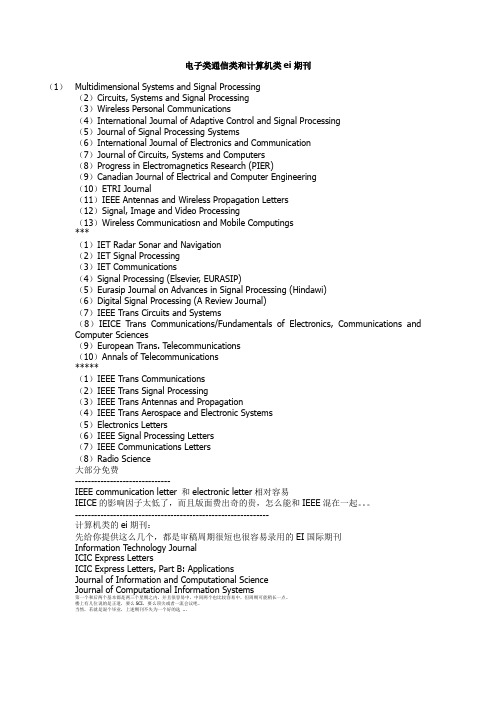
电子类通信类和计算机类ei期刊(1)Multidimensional Systems and Signal Processing(2)Circuits, Systems and Signal Processing(3)Wireless Personal Communications(4)International Journal of Adaptive Control and Signal Processing(5)Journal of Signal Processing Systems(6)International Journal of Electronics and Communication(7)Journal of Circuits, Systems and Computers(8)Progress in Electromagnetics Research (PIER)(9)Canadian Journal of Electrical and Computer Engineering(10)ETRI Journal(11)IEEE Antennas and Wireless Propagation Letters(12)Signal, Image and Video Processing(13)Wireless Communicatiosn and Mobile Computings***(1)IET Radar Sonar and Navigation(2)IET Signal Processing(3)IET Communications(4)Signal Processing (Elsevier, EURASIP)(5)Eurasip Journal on Advances in Signal Processing (Hindawi)(6)Digital Signal Processing (A Review Journal)(7)IEEE Trans Circuits and Systems(8)IEICE Trans Communications/Fundamentals of Electronics, Communications and Computer Sciences(9)European Trans. Telecommunications(10)Annals of Telecommunications*****(1)IEEE Trans Communications(2)IEEE Trans Signal Processing(3)IEEE Trans Antennas and Propagation(4)IEEE Trans Aerospace and Electronic Systems(5)Electronics Letters(6)IEEE Signal Processing Letters(7)IEEE Communications Letters(8)Radio Science大部分免费------------------------------IEEE communication letter 和electronic letter相对容易IEICE的影响因子太低了,而且版面费出奇的贵,怎么能和IEEE混在一起。
数字信号处理Digital Signal Processing(DSP)
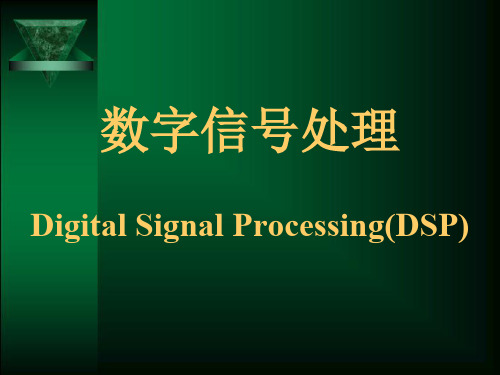
• 经过A/D变换器后,不但时间离散化了,幅度也量化 了,这种信号称为数字信号。用x(n)表示。
例子
• 如4位码,只能表示24=16种不同的信号幅度, 这些幅度称为量化电平。
• 当离散时间信号幅度与量化电平不相同时, 就要以最接近的一个量化电平来近似它。
(7)估计理论,包括功率谱估计及相关函数 估计等。
(8)信号的压缩,包括语音信号与图象信号 的压缩
(9)信号的建模,包括AR,MA,ARMA, CAPON,PRONY等各种模型。
(10)其他特殊算法(同态处理、抽取与内 插、信号重建等)
(11)数字信号处理的实现。
(12) 数字信号处理的应用。
第一节 什么是数字信号处理 第二节 数字信号处理的实现 第三节 数字信号处理的应用领域 第四节 数字信号处理器
例:直流信号:仅用一个参量可以描述。阶跃信号:可用幅 度和时间两个参量描述。正弦波信号:可用幅度、频率和 相位三个参量来描述。
• 随机信号:若信号在任意时刻的取值不能精确确定,或 说取值是随机的,即它不能用有限的参量加以描述。也无 法对它的未来值确定性地预测。它只能通过统计学的方法 来描述(概率密度函数来描述)。
• 随着信息时代、数字世界的到来,数字信号处 理已成为一门极其重要的学科和技术领域。
(四)数字信号处理系统的基本组成
• 以下所讨论的是模拟信号的数字信号处理系统.
模拟 前置预 滤波器
xa(t)
PrF
x(n)
y(n)
A/D 变换器
数字信号 处理器
D/A 变换器
ADC
DSP
电子科技大学-彭启琮-DSP视频配套PPT-1

DSP Solution
Programmable switch
Mobile phone
The handset is not only used for voice communication
from a number of potential forms of error. With information in a digital or binary form, we
may easily build into the data stream additional “redundant” bits that are used to detect when an error has occurred.
Digital system:will show no variation
with temperature throughout their guaranteed operation range.
Why digital?
(4) Anti-noise
Why digital?
(5) Repeatability
Why digital?
(3)Stability
Analog system:the characteristics of
analog system components, resistors, capacitors and operational amplifiers will change along with temperature, humidity
Why digital?
dsp大学期末考试试题及答案
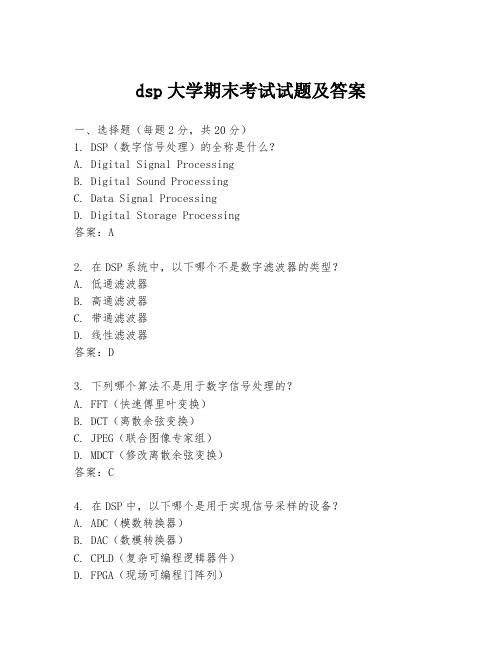
dsp大学期末考试试题及答案一、选择题(每题2分,共20分)1. DSP(数字信号处理)的全称是什么?A. Digital Signal ProcessingB. Digital Sound ProcessingC. Data Signal ProcessingD. Digital Storage Processing答案:A2. 在DSP系统中,以下哪个不是数字滤波器的类型?A. 低通滤波器B. 高通滤波器C. 带通滤波器D. 线性滤波器答案:D3. 下列哪个算法不是用于数字信号处理的?A. FFT(快速傅里叶变换)B. DCT(离散余弦变换)C. JPEG(联合图像专家组)D. MDCT(修改离散余弦变换)答案:C4. 在DSP中,以下哪个是用于实现信号采样的设备?A. ADC(模数转换器)B. DAC(数模转换器)C. CPLD(复杂可编程逻辑器件)D. FPGA(现场可编程门阵列)答案:A5. 下列哪个参数不是描述数字信号的?A. 幅度B. 频率C. 相位D. 电阻答案:D6. 在DSP中,以下哪个指标用于衡量信号的频域特性?A. 幅度谱B. 相位谱C. 功率谱D. 所有选项答案:D7. 下列哪个选项不是DSP系统设计的关键考虑因素?A. 处理速度B. 内存容量C. 电源电压D. 信号带宽答案:C8. 在DSP编程中,以下哪个不是常用的编程语言?A. C语言B. C++语言C. MATLABD. VHDL答案:C9. 下列哪个不是DSP系统的应用领域?A. 音频处理B. 图像处理C. 无线通信D. 机械制造答案:D10. 在DSP系统中,以下哪个是用于实现信号放大的组件?A. 运算放大器B. 滤波器C. 调制器D. 编码器答案:A二、填空题(每题2分,共20分)1. DSP技术在______和______处理中具有广泛应用。
答案:数字信号;模拟信号2. 一个典型的DSP系统包括______、______和______。
数字信号课程设计—钢琴琴键声音合成
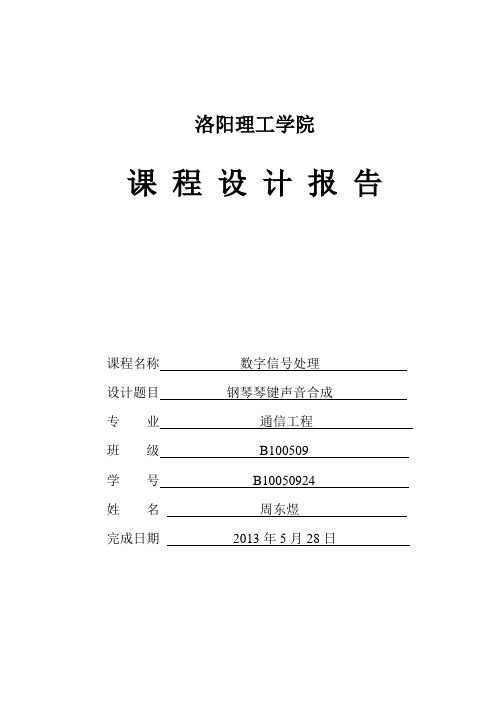
洛阳理工学院课程设计报告课程名称数字信号处理设计题目钢琴琴键声音合成专业通信工程班级B100509学号B********姓名周东煜完成日期2013年5月28日课程设计任务书设计题目:钢琴琴键声音合成设计内容与要求:钢琴声音优美号称“乐器之王”,据研究发现钢琴的声音是若干基本频率的倍频合成的。
弹奏钢琴产生16个音符,分别是“Do/Re/Mi/Fa/So/La/Si/Do(高)/Do(高)/Si/La/So/Fa/Mi/Re/Do”,对此信号进行STFT对此信号进行STFT,时频谱如图所示根据上述论述题目的基本要求如下:(1)找到Do/Re/Mi/Fa/So/La/Si/Do(高)的基频;(2)找出基频与倍频之间能量比率的关系;(3)编写函数,用正弦波来合成钢琴的声音。
指导教师:王新新2013年5 月27 日课程设计评语成绩:指导教师:2013年月日摘要目前,随着科技的不断发展,音频信号处理技术也发展异常迅猛,并且数字信号处理已成为主流。
运用计算机来处理数字信号,这就使得数字信号的处理速度非常快,这也是数字信号处理技术发展迅猛的主要原因。
将各种各样的音频信号转换为数字信号之后我们就可以快速而轻松的对这些音频信号进行处理了。
在这方面,早已出现如语音识别软件的各种关于音频信号处理的软件,随着计算机技术的持续发展,计算机运算速度的大幅提高,音频处理软件的处理能力越来越强。
以语音识别软件为例,现在的语音识别软件的识别准确度越来越高,识别速度越来越快,而今,我们运用的软件是matlab软件,这都主要归功于数字信号处理技术的发展。
所以说,用数字信号处理音频信号的发展前景非常广阔。
那么,我们就有理由选用数字信号处理的方法处理类似于钢琴音的音频信号。
钢琴声音优美,号称“乐器之王”,据研究发现钢琴的声音是若干基本频率的倍频合成的。
弹奏钢琴产生16个音符,分别是“Do/Re/Mi/Fa/So/La/Si/Do(高)/ Do(高)/Si/La/So/Fa/Mi/Re/Do”关键词:Matlab、电子琴、数字信号abstractAt present, with the continuous development of science and technology, audio signal processing technology and development of abnormal rapidly, and digital signal processing has become the mainstream. Use computer to deal with digital signal, which makes very fast digital signal processing, digital signal processing technology which is developing rapidly. Convert all kinds of audio signal to digital signal after, we can quickly and easily for the audio signal processing. In this respect, have appeared such as voice recognition software on audio signal processing software, with the continued development of computer technology, the computer operation speed increase, audio processing software processing power is more and more strong. V oice recognition software, for example, is now the voice recognition software is more and more high recognition accuracy, and speed faster and faster, but now, we use the software matlab software, this is mainly due to the development of digital signal processing technology. So, with the development of digital signal processing audio signal prospects are very broad. So, we have reasons to use digital signal processing method of similar steel sound audio signal processing.A beautiful piano sound, so-called \"the king of instruments\", according to research finds the sound of the piano is a number of basic frequency times frequency synthesis. Respectively, playing the piano have 16 notes, is \"Do Re Mi/Fa/So/La/Si/Do (high)/Do (high)/Si/La/So/Fa/Mi/Re/Do\"Key word: Matlab, electric piano, digital signa目录第一章系统运行环境 (4)1.1、MATLAB开发环境简介 (4)1.2 硬件环境 (5)第二章系统内容设计 (6)2.1、钢琴琴键合成原理 (6)2.2、总体结构图 (7)2.3、钢琴信号的时频分析 (8)2.4对时频谱进行分析 (10)第三章实验结果及其分析 (11)3.1、钢琴信号的合成 (12)3.2实验结果 (13)实验总结 (14)第一章系统运行环境1.1、MATLAB开发环境简介分析以及合成声音所需软件环境------MATLABMATLAB是矩阵实验室(Matrix Laboratory)的简称,是美国MathWorks公司出品的商业数学软件,用于算法开发、数据可视化、数据分析以及数值计算的高级技术计算语言和交互式环境,主要包括MATLAB和Simulink两大部分。
综合专业英语试题
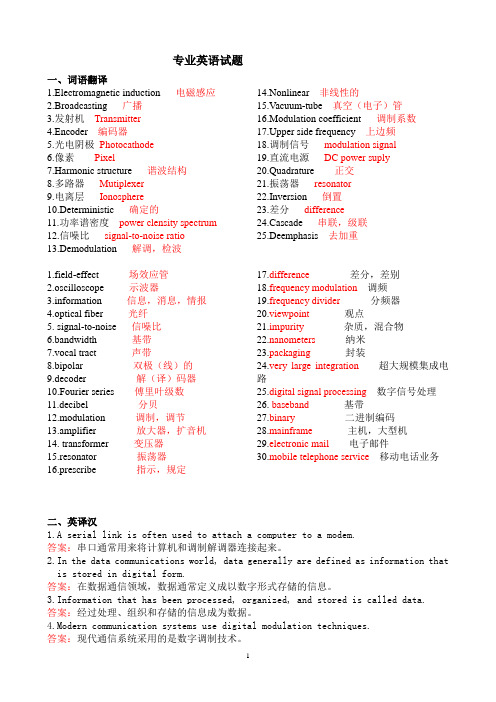
专业英语试题一、词语翻译1.Electromagnetic induction 电磁感应2.Broadcasting 广播3.发射机Transmitter4.Encoder 编码器5.光电阴极Photocathode6.像素Pixel7.Harmonic structure 谐波结构8.多路器Mutiplexer9.电离层Ionosphere10.Deterministic 确定的11.功率谱密度power clensity spectrum12.信噪比signal-to-noise ratio13.Demodulation 解调,检波14.Nonlinear 非线性的15.Vacuum-tube 真空(电子)管16.Modulation coefficient 调制系数17.Upper side frequency 上边频18.调制信号modulation signal19.直流电源DC power suply20.Quadrature 正交21.振荡器resonator22.Inversion 倒置23.差分difference24.Cascade 串联,级联25.Deemphasis 去加重1.field-effect 场效应管2.oscilloscope 示波器rmation 信息,消息,情报4.optical fiber 光纤5. signal-to-noise 信噪比6.bandwidth 基带7.vocal tract 声带8.bipolar 双极(线)的9.decoder 解(译)码器10.Fourier series 傅里叶级数11.decibel 分贝12.modulation 调制,调节13.amplifier 放大器,扩音机14. transformer 变压器15.resonator 振荡器16.prescribe 指示,规定17.difference差分,差别18.frequency modulation调频19.frequency divider分频器20.viewpoint 观点21.impurity杂质,混合物22.nanometers纳米23.packaging封装24.very large integration 超大规模集成电路25.digital signal processing数字信号处理26. baseband 基带27.binary二进制编码28.mainframe 主机,大型机29.electronic mail电子邮件30.mobile telephone service移动电话业务二、英译汉1.A serial link is often used to attach a computer to a modem.答案:串口通常用来将计算机和调制解调器连接起来。
南邮DSP期末复习课试卷
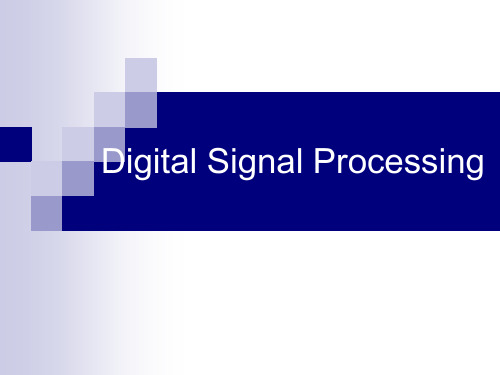
DTFT
连续周期频谱 X ( e j )
内 插
有限长离散时间信号 y[n]
DFT
2 0 ~ 2 ,间隔 N 频域采样
有限长离散谱线
Y (k )
第五章 重点
DFT的定义、性质及其证明 循环卷积与线性卷积的关系 实序列的DFT 线性卷积的DFT实现 重叠相加法
Let ga(t) be a band-limited signal with CTFT Ga(j)=0 for | |> m Then ga(t) is uniquely determined by its samples ga(nT) , -n, if T 2 m where T=2/T
连续时间信号 x(t)
内 插 时域采样
FT
连续频谱 X(jΩ)
周期延拓
离散时间信号 x(n)
周期延拓 取主值区间
DTFT
连续周期频谱 X ( e j )
内 插
有限长离散时间信号 y[n]
DFT
2 0 ~ 2 ,间隔 N 频域采样
有限长离散谱线
Y (k )
Sampling the DTFT
Sampling the DTFT
n
x[n]
实偶——实偶
实奇——虚奇
Commonly Used DTFT Pairs
Sequence DTFT
[ n] 1
1 e
jo n
k
2( 2 k) 2( o 2 k)
1 [ n] ( 2 k) j 1 e k 1 n [ n], ( 1) 1 e j
DigitalSignalProcessing(1Introduction)-讲义
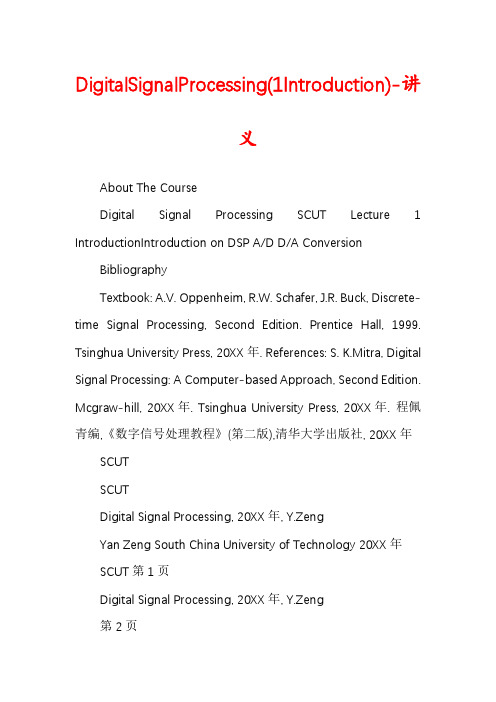
DigitalSignalProcessing(1Introduction)-讲义About The CourseDigital Signal Processing SCUT Lecture 1 IntroductionIntroduction on DSP A/D D/A Conversion BibliographyTextbook: A.V. Oppenheim, R.W. Schafer, J.R. Buck, Discrete-time Signal Processing, Second Edition. Prentice Hall, 1999. Tsinghua University Press, 20XX年. References: S. K.Mitra, Digital Signal Processing: A Computer-based Approach, Second Edition. Mcgraw-hill, 20XX年. Tsinghua University Press, 20XX年. 程佩青编,《数字信号处理教程》(第二版),清华大学出版社, 20XX年SCUTSCUTDigital Signal Processing, 20XX年, Y.ZengYan Zeng South China University of Technology 20XX年SCUT第1页Digital Signal Processing, 20XX年, Y.Zeng第2页About The Course Instructor: Yan Zeng,C Phone: 8711 4480 (H), 189 **** ****C Office: Building#18 (412)C E-Mail: yzeng@, zengyan.gz@C E-Mail for submitting reports: scutoptics@ Grading PolicyCExercises and Reports: 20%CFinal exam: 80% Exercises and Reports: There are proper exercises, homeworks or reports every week, which must be delivered on every Wednesday.Digital Signal Processing, 20XX年, Y.Zeng第3页About The CourseSCUT眼界决定境界,视野决定胸怀,行动决定命运!广泛阅读,善于思考,勤于实践!仰望星空,脚踏实地!SCUTI will give you many careful and trenchant discussion on DSP theories, methods and a wild view to modern science and technoloty. Wish you have a great journey in the course!SCUTSCUTDigital Signal Processing, 20XX年, Y.Zeng第4页Chapter 1 Introduction Background Aim Motivation What is DSP Characteristics of DSP Basic Framework Main Application and Some Examples Sampling and Quantization( A/D D/A Conversion)1.1 BackgroundSCUT建安24年(公元219年)腊月,曹操与华佗。
电子信息工程专业专业英语考卷
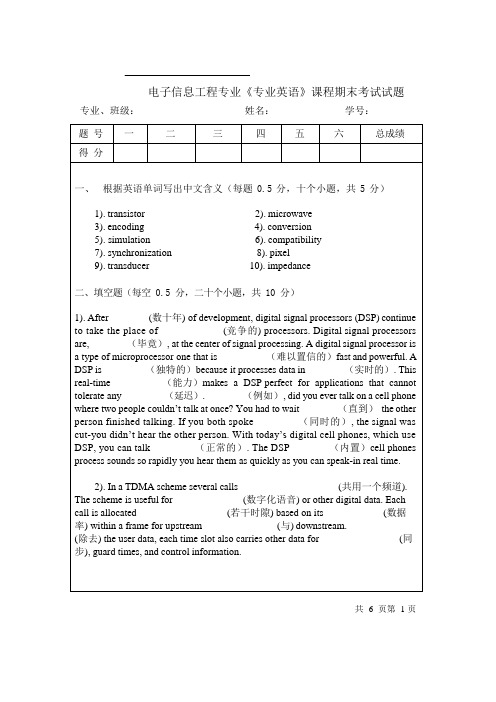
电子信息工程专业《专业英语》课程期末考试试题专业、班级:姓名:学号:共 6 页第 1 页三、根据英文缩写写出中文含义(每题 0.5 分,二十个小题,共 10 分)1). CDMA2). ALU3). DAS4). HLL5). SCR6). I/O7). MIPS8). MMX9). DCS10). HDD11). PLA12). VSWR13). DC14). FDM15). GBW16). TDM17). IP18). DCT19). MRI20). PCM四、将下列句子翻译为中文(每题 2 分,五个小题,共 10 分)1). At present, the state of most semiconductor device technology is such that the device design and process technology must be supplemented by screening and inspection procedures, if ultimate device reliability is to be obtained and controlled.2). The converter is essentially a highly over –sampling 1-bit ADC (the comparator) followed by digital filtering and decimation to realize the processing gain. The effective performance of the converter is greatly enhanced by the addition of circuitry to shape the quantization noise such that, instead of being uniformly spread throughout the 0 to fs/2 band, it is minimized in the band of interest.3). Although the individual integrated circuits might cost as little as 10 cents each, the cost of designing the printed circuit board for such a system and the cost of assembling the board are very significant and this design style is no longer cost-effective.4). Rather than just matching the abilities of the human ear, these systems are designed to exceed the limits of hearing. It's the only way to be sure that the reprod uced music is pristine.5). In the case that the object types in a video sequence belong to known object classes, knowledge-based coding can be employed, which uses a wireframe specially designed to describe the recognized object type. Several approaches have been developed to code human heads using predefined wireframes. Using a predefined wireframe increases coding efficiency because it is adapted to the shape of the object. Sometimes. this technique is also referred to as model based coding.五、将下列句子翻译为相应的英文(每题 3 分,五个小题,共 30 分)1). 在测量应用中,选择合适的探头是获得最佳信号保真度的关键。
电子信息工程专业专业英语考卷

电子信息工程专业《专业英语》课程期末考试试题专业、班级:姓名:学号:共 6 页第 1 页三、根据英文缩写写出中文含义(每题 0.5 分,二十个小题,共 10 分)1). CDMA2). ALU3). DAS4). HLL5). SCR6). I/O7). MIPS8). MMX9). DCS10). HDD11). PLA12). VSWR13). DC14). FDM15). GBW16). TDM17). IP18). DCT19). MRI20). PCM四、将下列句子翻译为中文(每题 2 分,五个小题,共 10 分)1). At present, the state of most semiconductor device technology is such that the device design and process technology must be supplemented by screening and inspection procedures, if ultimate device reliability is to be obtained and controlled.2). The converter is essentially a highly over –sampling 1-bit ADC (the comparator) followed by digital filtering and decimation to realize the processing gain. The effective performance of the converter is greatly enhanced by the addition of circuitry to shape the quantization noise such that, instead of being uniformly spread throughout the 0 to fs/2 band, it is minimized in the band of interest.3). Although the individual integrated circuits might cost as little as 10 cents each, the cost of designing the printed circuit board for such a system and the cost of assembling the board are very significant and this design style is no longer cost-effective.4). Rather than just matching the abilities of the human ear, these systems are designed to exceed the limits of hearing. It's the only way to be sure that the reprod uced music is pristine.5). In the case that the object types in a video sequence belong to known object classes, knowledge-based coding can be employed, which uses a wireframe specially designed to describe the recognized object type. Several approaches have been developed to code human heads using predefined wireframes. Using a predefined wireframe increases coding efficiency because it is adapted to the shape of the object. Sometimes. this technique is also referred to as model based coding.五、将下列句子翻译为相应的英文(每题 3 分,五个小题,共 30 分)1). 在测量应用中,选择合适的探头是获得最佳信号保真度的关键。
《计算机英语》 司爱侠,人民邮电出版社答案-推荐下载
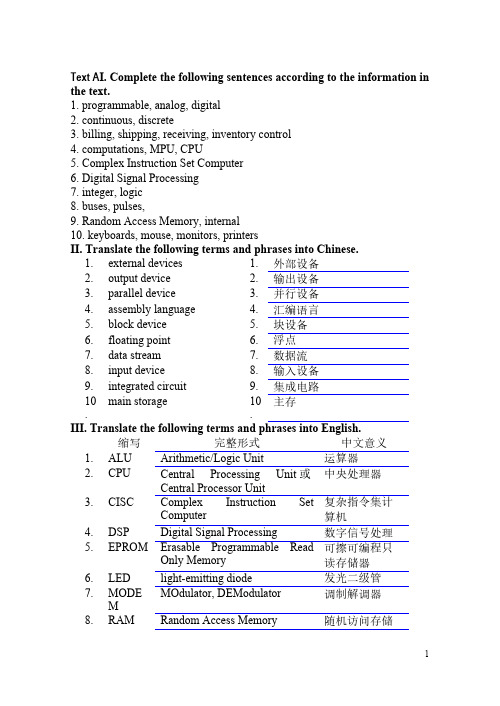
Text A I. Complete the following sentences according to the information in the text.1. programmable, analog, digital2. continuous, discrete3. billing, shipping, receiving, inventory control4. computations, MPU, CPU5. Complex Instruction Set Computer6. Digital Signal Processing7. integer, logic8. buses, pulses,9. Random Access Memory, internal10. keyboards, mouse, monitors, printersII. Translate the following terms and phrases into Chinese.1.external devices 1.外部设备2.output device 2.输出设备3.parallel device 3.并行设备4.assembly language 4.汇编语言5.block device 5.块设备6.floating point 6.浮点7.data stream7.数据流8.input device8.输入设备9.integrated circuit9.集成电路10 .main storage10.主存III. Translate the following terms and phrases into English.缩写完整形式中文意义1.ALU Arithmetic/Logic Unit运算器2.CPU Central Processing Unit或Central Processor Unit中央处理器3.CISC Complex Instruction SetComputer 复杂指令集计算机4.DSP Digital Signal Processing数字信号处理5.EPROM Erasable Programmable ReadOnly Memory 可擦可编程只读存储器6.LED light-emitting diode发光二级管7.MODEMMOdulator, DEModulator调制解调器8.RAM Random Access Memory随机访问存储器9.ROM Read Only Memory只读存储器10 .RISC Reduced Instruction SetComputer精简指令集计算机IV. Fill in the gaps with the words or phrases chosen from the box. Change the forms where necessary.1. instructions 2. devices 3. concept 4. consuming 5. integrated circuits6. space7. fit into8. Information Age9. embedded computer 10. controlV. Translate the following passage into Chinese.计算机能够储存和执行被叫做程序的许多指令,这使其非常通用并不同于计算器。
数字信号处理 英文 教材

数字信号处理英文教材
数字信号处理是一门涉及数学、工程学和计算机科学的学科,其英文教材有很多,以下是一些经典的数字信号处理英文教材:
1. "Digital Signal Processing" by John G. Proakis and Masoud Salehi
2. "Digital Signal Processing: Principles, Algorithms, and Applications" by Robert J. Schroeder and Ray P. Kailath
3. "Digital Signal Processing: A Practical Guide for Applications Engineers" by Robert A. Monzingo and John W. Cocke
4. "Digital Signal Processing: A Computer-Based Approach" by John
G. Proakis and Dimitris G. Manolakis
5. "Digital Signal Processing: Theory, Algorithms, and Practicalities" by John G. Proakis and Gilbert H. Walker
这些教材都是非常经典的数字信号处理教材,被广泛应用于数字信号处理领域。
它们涵盖了数字信号处理的基本概念、原理、算法和应用,适合初学者和有一定基础的读者。
信息科学与电子工程专业英语课后答案
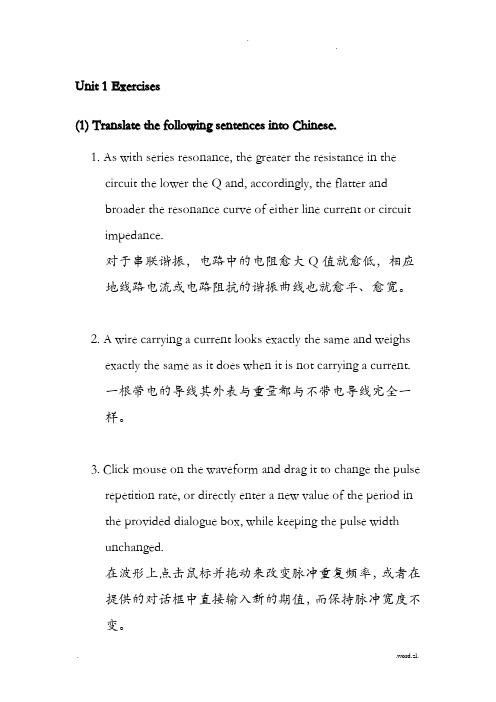
U n i t1E x e r c i s e s(1)T r a n s l a t e t h e f o l l o w i n g s e n t e n c e s i n t o C h i n e s e.1.As with series resonance, the greater the resistance in thecircuit the lower the Q and, accordingly, the flatter andbroader the resonance curve of either line current or circuitimpedance.对于串联谐振,电路中的电阻愈大Q值就愈低,相应地线路电流或电路阻抗的谐振曲线也就愈平、愈宽。
2.A wire carrying a current looks exactly the same and weighsexactly the same as it does when it is not carrying a current.一根带电的导线其外表与重量都与不带电导线完全一样。
3.Click mouse on the waveform and drag it to change the pulserepetition rate, or directly enter a new value of the period inthe provided dialogue box, while keeping the pulse widthunchanged.在波形上点击鼠标并拖动来改变脉冲重复频率,或者在提供的对话框中直接输入新的期值,而保持脉冲宽度不变。
4.Electronics is the science and the technology of the passage of charged particles in a gas, in a vacuum, or in a semiconductor. Please note that particle motion confined within a metal only is not considered electronics.电子学是一门有关带电粒子在气体、真空或半导体中运动的科学技术。
数字信号处理-基于计算机的方法(第四版)答案8-11章(20161119181250)
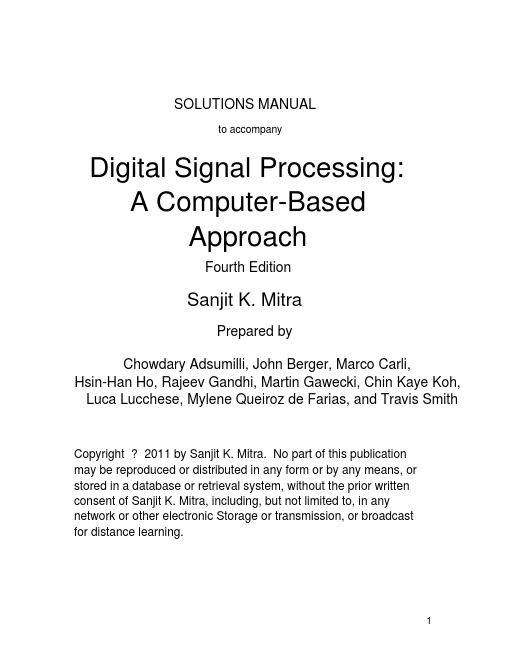
6
+(1-
5 -2 z 4
+
1 -4 z )Y( z2 ) 4
+
2 3
( z- 1
+ z- 2 -
1 -3 z 4
-
1 -4 z )Y(z3) 4
+ + +
1 24 1 12 1
Y(z0) + Y( z0 ) +
1 6
2 3 1 6
Y(z1) Y(z1 ) 1 4
5 4 1 6
Y(z2 ) +
2 3 1
D = 3〈 3 〉 4 = 3. k=〈 4 k1 + 3k2 〉 12 ,
-1
Thus, n = 〈 4 n1 + 3n 2 〉 12 ,
0 ≤k1 ≤2, 0 ≤k2 ≤3.
0 ≤n 1 ≤2, 0 ≤n 2 ≤3,
The corresponding index mappings are indicated below:
From Eqs. (6.114) and (6.115), we arrive at I 0 (z) I1 ( z) I 2 (z) Y( z) = Y( z0 ) + Y(z1) + Y( z2 ) + I 0 (z0 ) I1 (z1) I 2 ( z2 ) where I 0 (z) = (1 - z1 z- 1)(1- z2 z- 1 )(1- z3z- 1 )(1 - z4 z- 1 ), I 1( z) = (1- z0 z- 1)(1I 2 (z) = (1 - z0 z- 1)(1 z2 z- 1 )(1- z3z- 1 )(1 - z4 z- 1 ), z1 z- 1 )(1- z3z- 1 )(1 - z4 z- 1 ),
Digital Signal Processing
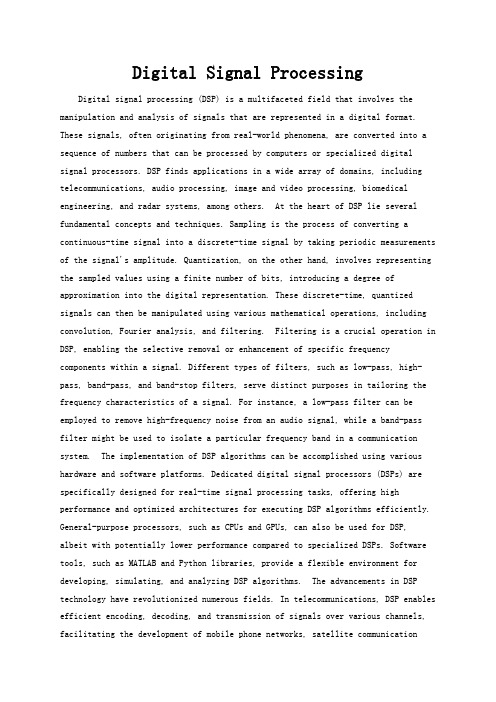
Digital Signal Processing Digital signal processing (DSP) is a multifaceted field that involves the manipulation and analysis of signals that are represented in a digital format. These signals, often originating from real-world phenomena, are converted into a sequence of numbers that can be processed by computers or specialized digital signal processors. DSP finds applications in a wide array of domains, including telecommunications, audio processing, image and video processing, biomedical engineering, and radar systems, among others. At the heart of DSP lie several fundamental concepts and techniques. Sampling is the process of converting a continuous-time signal into a discrete-time signal by taking periodic measurements of the signal's amplitude. Quantization, on the other hand, involves representing the sampled values using a finite number of bits, introducing a degree of approximation into the digital representation. These discrete-time, quantized signals can then be manipulated using various mathematical operations, including convolution, Fourier analysis, and filtering. Filtering is a crucial operation in DSP, enabling the selective removal or enhancement of specific frequency components within a signal. Different types of filters, such as low-pass, high-pass, band-pass, and band-stop filters, serve distinct purposes in tailoring the frequency characteristics of a signal. For instance, a low-pass filter can be employed to remove high-frequency noise from an audio signal, while a band-pass filter might be used to isolate a particular frequency band in a communication system. The implementation of DSP algorithms can be accomplished using various hardware and software platforms. Dedicated digital signal processors (DSPs) are specifically designed for real-time signal processing tasks, offering high performance and optimized architectures for executing DSP algorithms efficiently. General-purpose processors, such as CPUs and GPUs, can also be used for DSP,albeit with potentially lower performance compared to specialized DSPs. Software tools, such as MATLAB and Python libraries, provide a flexible environment for developing, simulating, and analyzing DSP algorithms. The advancements in DSP technology have revolutionized numerous fields. In telecommunications, DSP enables efficient encoding, decoding, and transmission of signals over various channels, facilitating the development of mobile phone networks, satellite communicationsystems, and high-speed internet access. Audio processing heavily relies on DSPfor tasks like noise reduction, echo cancellation, equalization, and audio compression, enhancing the quality of music recordings, voice communication, and sound effects in multimedia applications. Image and video processing leverage DSP for tasks such as image enhancement, compression, object recognition, and video stabilization, contributing to advancements in digital photography, medical imaging, video surveillance, and computer vision. The field of biomedical engineering utilizes DSP for analyzing physiological signals like electrocardiograms (ECGs), electroencephalograms (EEGs), and electromyograms (EMGs), aiding in medical diagnosis, monitoring, and treatment. Radar systems rely on DSP for tasks like target detection, tracking, and imaging, playing a crucial role in aviation, weather forecasting, and military applications. These examples merely scratch the surface of the vast and ever-expanding applications of DSP in shaping our technological landscape.。
数字信号处理DigitalSignalProcessing

9
2. 基本组成
模拟信 号
连续时间信 号
数字信号
采样 保持器
A/D 变换器
通用或专 用
计算机
连续时间信 模 拟 信
号
号
D/ A 变换器模拟低通 滤ຫໍສະໝຸດ 器数字信号处理系统10
11
12
3. 实现方法(软硬兼有)
▪ (1) 在通用的计算机(如PC机)上用软件(如Fortran、C
14
4. 数字信号处理特点
▪ 精度高:在模拟系统的电路中,元器件精度要达
到10-3以上已经不容易了,而数字系统17位字长 可以达到10-5的精度,这是很平常的。例如,基 于离散傅里叶变换的数字式频谱分析仪,其幅值 精度和频率分辨率均远远高于模拟频谱分析仪。
▪ 灵活性强:数字信号处理采用了专用或通用的数字系
速发展的另一个标志,40年代~60年代中期,形成了完整 的理论基础(FIR & IIR); ▪ 有限冲击响应(FIR-Finite Impulse Response); ▪ 无限冲击响应(IIR-Infinite Impulse Response);
▪ 三个著名的DSP实验室:
▪ Bell实验室、IBM的Watson实验室、MIT的Lincoln实验 室。
▪ 可以实现多维信号处理:利用庞大的存储单元,可以
存储二维的图像信号或多维的阵列信号,实现二维或多维 的滤波及谱分析等。
16
▪ 缺点1:增加了系统的复杂性,它需要模拟
接口以及比较复杂的数字系统;
▪ 缺点2:应用的频范围受到限制,主要是
A/D转换的采样频率的限制;
▪ 缺点3:系统的功率消耗比较大。数字信号
数字信号处理DiscreteTimeSignalProcessing
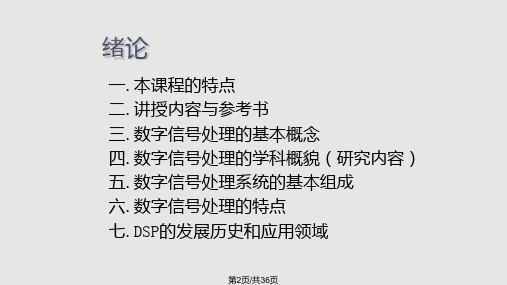
Device)
复杂可编程逻辑器件
4.Embedded Processor 嵌入式处理器
第34页/共36页
应用领域
数字信号处理是应用最快、成效最为显著的 新学科之一。在语音、雷达、声纳、地震、图像、 通信系统、系统控制、生物医学工程、机械振动、 遥感遥测、地质勘探、航空航天、电力系统、故障 检测、自动化仪器等众多领域都获得了极其广泛的 应用,它有效地推动了众多工程技术领域的技术改 造和学科发展。近年来,随着多媒体的发展, DSP芯片已在家电、电话、磁盘机等设备中广泛 应用。毫不夸张地说,只要你使用计算机(通用机、 专用机、单板机、单片机或一个简单的CPU)和数 据打交道,就必然要应用数字信号处理技术。
(1) 在通用微机上,用软件实现; (2) 用单片机实现; (3) 专用数字信号处理芯片DSP。
第21页/共36页
五. 数字信号处理系统的基本组成
1. 框图
xa (t) 前置预滤波器
A/D变换器 x(n) 数字信号处理器
y(n) D/A变换器 y(t) 模拟滤波器 ya (t)
' xa (t)
01 3 5 t
7. 便于二维与多维处理 用存储一帧或数帧图象信号,实现二、多维 处理。
8. 速度不够高,工作频率也不够高 几十MHz以下。
第28页/共36页
技术发展趋势 可用四个字“多快好省”来概括。 1.多,DSP的型号越来越多; 2.快,即运算的速度越来越快; 3.好,主要是指性能价格比; 4.省,功耗越来越低。
2. 要求基础强
网络理论、信号与系统是本课程的理论基础。
3. 与其它学科密切相连
与最优控制、通信理论、故障诊断、计算机、 微电子技术不可分,又是人工智能、模式识别、 神经网络等新兴学科的理论基础之一。
Artech House, 1999.
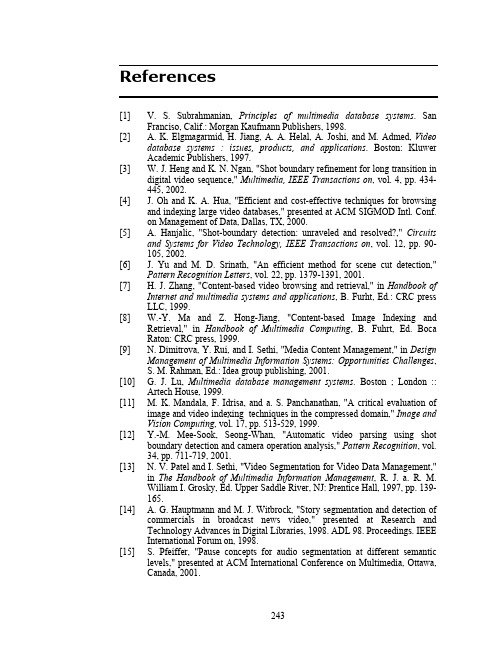
ReferencesSubrahmanian,S.[1] V.Principles of multimedia database systems. San Franciso, Calif.: Morgan Kaufmann Publishers, 1998.[2] A. K. Elgmagarmid, H. Jiang, A. A. Helal, A. Joshi, and M. Admed, Videodatabase systems : issues, products, and applications. Boston: Kluwer Academic Publishers, 1997.[3] W. J. Heng and K. N. Ngan, "Shot boundary refinement for long transition indigital video sequence," Multimedia, IEEE Transactions on, vol. 4, pp. 434-445, 2002.[4] J. Oh and K. A. Hua, "Efficient and cost-effective techniques for browsingand indexing large video databases," presented at ACM SIGMOD Intl. Conf.on Management of Data, Dallas, TX, 2000.[5] A. Hanjalic, "Shot-boundary detection: unraveled and resolved?," Circuitsand Systems for Video Technology, IEEE Transactions on, vol. 12, pp. 90-105, 2002.[6] J. Yu and M. D. Srinath, "An efficient method for scene cut detection,"Pattern Recognition Letters, vol. 22, pp. 1379-1391, 2001.[7] H. J. Zhang, "Content-based video browsing and retrieval," in Handbook ofInternet and multimedia systems and applications, B. Furht, Ed.: CRC pressLLC, 1999.[8] W.-Y. Ma and Z. Hong-Jiang, "Content-based Image Indexing andRetrieval," in Handbook of Multimedia Computing, B. Fuhrt, Ed. Boca Raton: CRC press, 1999.[9] N. Dimitrova, Y. Rui, and I. Sethi, "Media Content Management," in DesignManagement of Multimedia Information Systems: Opportunities Challenges,S. M. Rahman, Ed.: Idea group publishing, 2001.[10] G. J. Lu, Multimedia database management systems. Boston ; London ::Artech House, 1999.[11] M. K. Mandala, F. Idrisa, and a. S. Panchanathan, "A critical evaluation ofimage and video indexing techniques in the compressed domain," Image andVision Computing, vol. 17, pp. 513-529, 1999.[12] Y.-M. Mee-Sook, Seong-Whan, "Automatic video parsing using shotboundary detection and camera operation analysis," Pattern Recognition, vol.34, pp. 711-719, 2001.[13] N. V. Patel and I. Sethi, "Video Segmentation for Video Data Management,"in The Handbook of Multimedia Information Management, R. J. a. R. M.William I. Grosky, Ed. Upper Saddle River, NJ: Prentice Hall, 1997, pp. 139-165.[14] A. G. Hauptmann and M. J. Witbrock, "Story segmentation and detection ofcommercials in broadcast news video," presented at Research and Technology Advances in Digital Libraries, 1998. ADL 98. Proceedings. IEEEInternational Forum on, 1998.[15] S. Pfeiffer, "Pause concepts for audio segmentation at different semanticlevels," presented at ACM International Conference on Multimedia, Ottawa,Canada, 2001.243REFERENCES[16] T. Lin and H.-J. Zhang, "Automatic video scene extraction by shot grouping,"presented at Pattern Recognition, 2000. Proceedings. 15th International Conference on, 2000.[17] J. R. Kender and B.-L. Yeo, "Video scene segmentation via continuous videocoherence," presented at Computer Vision and Pattern Recognition, 1998.Proceedings. 1998 IEEE Computer Society Conference on, 1998.[18] C. G. M. Snoek and M. Worring, "Multimodal Video Indexing: A Review ofthe State-of-the-art," University of Amsterdam, Amsterdam, Netherland, ISIStechnical report series, Vol. 2001-20 December 2001 2001.[19] Y. Wang, Z. Liu, and J.-C. Huang, "Multimedia content analysis-using bothaudio and visual clues," IEEE Signal Processing Magazine, vol. 17, pp. 12-36, 2000.[20] T. Kientzle, A programmer's guide to sound: Reading, Mass. : Addison-Wesley Developers Press, 1998.[21] T. Zhang and C.-C. Jay Kuo, "Audio content analysis for online audiovisualdata segmentation and classification," Speech and Audio Processing, IEEE Transactions on, vol. 9, pp. 441-457, 2001.[22] J. Hao, L. Tong, and Z. Hong-Jiang, "Video segmentation with the assistanceof audio content analysis," Multimedia and Expo, 2000. ICME 2000. 2000 IEEE International Conference on, vol. 3, pp. 1507-1510 vol.3, 2000.[23] Y. W. Z. L. J.-C. Huang, "Multimedia content analysis-using both audio andvisual clues," IEEE Signal Processing Magazine, vol. 17, pp. 12-36, 2000. [24] W. M. Hartman, Signals, sound and sensation: Woodbury, N.Y. : AmericanInstitute of Physics, 1997.[25] L. Lu, H. Jiang, and H. Zhang, "A robust audio classification andsegmentation method," presented at Proceedings of the ninth ACM international conference on Multimedia, Ottawa, Canada, 2001.[26] V. K. Ingle and J. G. Proakis, Digital signal processing using MATLAB.Pacific Grove, CA: Brooks/Cole Pub, 2000.[27] B. Boashash and A. M. Zoubir, Digital signal processing. Brisbane:Queensland University of Technology, Signal Processing Research Centre, 1995.[28] S. K. Mitra, Digital signal processing : a computer-based approach, 2nd ed.Boston: McGraw-Hill/Irwin, 2001.[29] Y. Zhang and T.-S. Chua, "Detection of text captions in compressed domainvideo," presented at Proceedings of the 2000 ACM workshops on Multimedia, Los Angeles, California, United States, 2000.[30] T. Sato, T. Kanade, E. K. Hughes, and M. A. Smith, "Video OCR for digitalnews archive," presented at Content-Based Access of Image and Video Database, 1998. Proceedings., 1998 IEEE International Workshop on, 1998. [31] S. C. Antani, D.; Kasturi, R., "Robust extraction of text in video," presentedat Pattern Recognition, 2000. Proceedings. 15th International Conference on, 2000.[32] R. Lienhart and A. Wernicke, "Localizing and segmenting text in images andvideos," Circuits and Systems for Video Technology, IEEE Transactions on,vol. 12, pp. 256-268, 2002.[33] R. Lienhart, "Automatic text recognition for video indexing," presented atProceedings of the fourth ACM international conference on Multimedia, Boston, Massachusetts, United States, 1996.244REFERENCES[34] T. H. Mita, O., "Improvement of video text recognition by characterselection," presented at Document Analysis and Recognition, 2001.Proceedings. Sixth International Conference on, 2001.[35] D. K. Crandall, R., "Robust detection of stylized text events in digital video,"presented at Document Analysis and Recognition, 2001. Proceedings. Sixth International Conference on, 2001.[36] A. L. Wernicke, R., "On the segmentation of text in videos," presented atMultimedia and Expo, 2000. ICME 2000. 2000 IEEE International Conference on, 2000.[37] E. Y. Kim, K. I. Kim, K. Jung, and H. J. Kim, "A video indexing systemusing character recognition," presented at Consumer Electronics, 2000. ICCE.2000 Digest of Technical Papers. International Conference on, 2000.[38] P. E. Natarajan, B.; Schwartz, R.; Makhoul, J., "Videotext OCR using hiddenMarkov models," presented at Document Analysis and Recognition, 2001.Proceedings. Sixth International Conference on, 2001.[39] L. D. Agnihotri, N., "Text detection for video analysis," presented at Content-Based Access of Image and Video Libraries, 1999. (CBAIVL '99) Proceedings. IEEE Workshop on, 1999.[40] R. Tusch, H. Kosch, and L. Böszörményi, "VIDEX: an integrated genericvideo indexing approach," presented at The eighth ACM international conference on Multimedia, Marina del Rey, California, United States, 2000. [41] C. Djeraba, "Content-based multimedia indexing and retrieval," Multimedia,IEEE, vol. 9, pp. 18-22, 2002.[42] G. Ahanger and T. D. C. Little, "Data semantics for improving retrievalperformance of digital news video systems," Knowledge and Data Engineering, IEEE Transactions on, vol. 13, pp. 352-360, 2001.[43] A. Ekin, A. M. Tekalp, and R. Mehrotra, "Integrated semantic-syntactic videoevent modeling for search and retrieval," presented at Image Processing.2002. Proceedings. 2002 International Conference on, 2002.[44] R. M. Leonardi, P., "Semantic indexing of multimedia documents,"Multimedia, IEEE, vol. 9, pp. 44-51, 2002.[45] E. Oomoto and K. Tanaka, "Video Database Systems - Recent Trends inResearch and Development Activities," in The Handbook of Multimedia Information Management, R. J. a. R. M. William I. Grosky, Ed. Upper SaddleRiver, NJ: Prentice Hall, 1997, pp. 405 - 448.[46] D. Ponceleon, S. Srinivasan, A. Amir, D. Petkovic, and D. Diklic, "Key toeffective video retieval: Effective cataloging and browsing," presented at IEEE Internation Workshop on Content-based image and video databases, Bombay, India, 1998.[47] A. R. Divakaran, R.; Peker, K.A., "Motion activity-based extraction of key-frames from video shots," presented at Image Processing. 2002. Proceedings.2002 International Conference on, 2002.[48] Y. Rui, T. S. Huang, M. Ortega, and S. Mehrotra, "Relevance Feedback: APower Tool for Interactive Content-Based Image Retrieval," IEEEtransaction on Circuits and Systems for Video Technology, vol. 8, pp. 644-655, 1998.[49] R. Wang, M. R. Naphade, and T. S. Huang, "Video retrieval and relevancefeedback in the context of a post-integration model," presented at IEEE Fourth Workshop on Multimedia Signal Processing, 2001.245REFERENCES[50] D. DeMenthon, L. J. Latecki, A. Rosenfeld, and M. V. Stuckelberg,"Relevance Ranking of Video Data Using Hidden Markov Model Distances and Polygon," presented at ICVIS Fourth International Conference on Visual Information Systems, Lyon, France, 2000.[51] Y.-F. Ma and H. J. Zhang, "Video snapshot: a bird view of video sequence,"presented at The 11th International Conference on Multimedia Modeling, Melbourne, Australia, 2005.[52] M. Irani and Anandan, "Video indexing based on mosaic representations,"Proceedings of the IEEE, vol. 86 (5), pp. 905-921, 1998.[53] Y. Taniguchi, A. Akutsu, and Y. Tonomura, "PanoramaExcerpts: extractingand packing panoramas for video browsing," presented at The fifth ACM international conference on Multimedia, Seattle, Washington, United States, 1997.[54] C. Kim and J.-N. Hwang, "Fast and automatic video object segmentation andtracking for content-based applications," Circuits and Systems for Video Technology, IEEE Transactions on, vol. 12, pp. 122-129, 2002.[55] T. C. Schoepflin, V.; Haynor, D.R.; Yongmin Kim, "Video object trackingwith a sequential hierarchy of template deformations," Circuits and Systems for Video Technology, IEEE Transactions on, vol. 11, pp. 1171-1182, 2001. [56] C. Yajima, Y. Nakanishi, and K. Tanaka, "Querying video data by spatio-temporal relationships of moving object traces," presented at 6th IFIP Working Conference on Visual Database Systems, Brisbane, 2002.[57] H. Miyamori and S.-I. Iisaku, "Video annotation for content-based retrievalusing human behavior analysis and domain knowledge," presented at Automatic Face and Gesture Recognition, 2000. Proceedings. Fourth IEEE International Conference on, Commun. Res. Lab., Minist. of Posts & Telecommun., Koganei, Japan, 2000.[58] B. Li and M. Ibrahim Sezan, "Event detection and summarization in sportsvideo," presented at Content-Based Access of Image and Video Libraries, 2001. (CBAIVL 2001). IEEE Workshop on, Sharp Labs. of America, Camas, WA, USA, 2001.[59] L. Zeinik-Manor and M. Irani, "Event-based analysis of video," presented atComputer Vision and Pattern Recognition, 2001. CVPR 2001. Proceedings of the 2001 IEEE Computer Society Conference on, The Weizmann Institute of Science, 2001.[60] N. Babaguchi, Y. Kawai, and T. Kitahashi, "Event based indexing ofbroadcasted sports video by intermodal collaboration," Multimedia, IEEE Transactions on, vol. 4, pp. 68-75, 2002.[61] M. Teraguchi, K. Masumitsu, T. Echigo, S. Sekiguchi, and M. Etoh, "Rapidgeneration of event-based indexes for personalized video digests," presented at Pattern Recognition, 2002. Proceedings. 16th International Conference on, 2002.[62] C. Wu, Y.-F. Ma, H.-J. Zhang, and Y.-Z. Zhong, "Events recognition bysemantic inference for sports video," presented at Multimedia and Expo, 2002. Proceedings. 2002 IEEE International Conference on, 2002.[63] A. Kokaram and P. Delacourt, "A new global motion estimation algorithmand its application to retrieval in sports events," presented at Multimedia Signal Processing, 2001 IEEE Fourth Workshop on, 2001.[64] A. Hampapur and R. Jain, "Video Data Management Systems: Metadata andArchitecture," in Multimedia data management : using metadata to integrate246REFERENCESand apply digital media, A. Sheth and W. Klas, Eds. New York: McGraw-Hill, 1998.[65] J. M. Martinez, R. Koenen, and F. Pereira, "MPEG-7: the generic multimediacontent description standard, part 1," Multimedia, IEEE, vol. 9, pp. 78-87,2002.[66] P. Salembier, J. Llach, and L. Garridoa, "Visual segment tree creation forMPEG-7 Description Schemes," Pattern Recognition, vol. 35, pp. 563-579,2002.[67] M. Abdel-Mottaleb and S. Krishnamachari, "Multimedia Descriptions Basedon MPEG-7 Extraction and Applications," IEEE Transactions on Multimedia,vol. 6(3), pp. 459-468, 2004.[68] F. L. Nack, A.T., "Everything you wanted to know about MPEG-7. 2,"Multimedia, IEEE, vol. 6, pp. 64-73, 1999.[69] F. Pereira, "MPEG-7 requirements Document V.14. International,International Organisation For Standardisation, Coding of Moving Picturesand Audio," International Organisation For Standardisation, Coding of Moving Pictures and Audio ISO/IEC JTC 1/SC 29/WG 11/N4035, Singapore2001.[70] S.-F. Chang, T. Sikora, and A. Purl, "Overview of the MPEG-7 standard,"Circuits and Systems for Video Technology, IEEE Transactions on, vol. 11,pp. 688-695, 2001.[71] P. B. Van Beek, A.B.; Heuer, J.; Martinez, J.; Salembier, P.; Shibata, Y.,Smith, J.R.; and Walker, T., "Text of 15938-5 FCD Information Technology -Multimedia Content Description Interface - Part 5 Multimedia DescriptionSchemes," International Organisation For Standardisation, Coding of MovingPictures and Audio, ISO/IEC JTC 1/SC 29/WG 11/N3966,, Singapore 2001. [72] S. Satoh, Y. Nakamura, and T. Kanade, "Name-It: naming and detectingfaces in news videos," Multimedia, IEEE, vol. 6, pp. 22-35, 1999.[73] K. Young-tae and C. Tat-Seng, "Retrieval of news video using videosequence matching," presented at The 11th Internation Conference on Multimedia Modeling, Melbourne, Australia, 2004.[74] M. Fayzullin, V. S. Subrahmanian, A. Picariello, and M. L. Sapino, "TheCPR model for summarizing video," presented at The first ACM internationalworkshop on Multimedia databases,, New Orleans, USA, 2003.[75] T. Moriyama and M. Sakauchi, "Video summarisation based on thepsychological content in the track structure," presented at The ACM workshops on Multimedia, New York, USA, 2000.[76] Y.-F. Ma, L. Lu, Z. Hong-Jiang, and M. Li, "A user attention model for videosummarization," presented at ACM International conference on Multimedia,France, 2002.[77] B. Yu, W.-Y. Ma, K. Nahrstedt, and H.-J. Zhang, "Video summarizationbased on user log enhanced link analysis," presented at The eleventh ACMinternational conference on Multimedia, Berkeley, CA, USA, 2003.[78] T. Syeda-Mahmood and D. Ponceleon, "Learning video browsing behaviorand its application in the generation of video previews," presented at Theninth ACM international conference on Multimedia, Ottawa, Canada, 2001. [79] F. Jing, M. Li, Z. Hong-Jiang, and B. Zhang, "An efficient and effectiveregion-based image retrieval framework," IEEE Transaction on Image Processing, vol. 13 (5), pp. 699-709, 2004.247REFERENCES[80] D. Zhong and S.-F. Chang, "Structure Analysis of Sports Video UsingDomain Models," presented at IEEE ICME 2001, Tokyo, Japan, 2001.[81] G. Sudhir, J. C. M. Lee, and A. K. Jain, "Automatic classification of tennisvideo for high-level content-based retrieval," presented at Content-Based Access of Image and Video Database, 1998. Proceedings., 1998 IEEE International Workshop on, Dept. of Comput. Sci., Hong Kong Univ. of Sci.,Hong Kong, 1998.[82] L. Xie, S.-F. Chang, A. Divakaran, and H. Sun, "Structure analysis of soccervideo with hidden Markov models," presented at Acoustics, Speech, and Signal Processing, 2002 IEEE International Conference on, Columbia University, 2002.[83] Y. Gong, L. T. Sin, C. H. Chuan, H. Zhang, and M. Sakauchi, "Automaticparsing of TV soccer programs," presented at Multimedia Computing andSystems, 1995., Proceedings of the International Conference on, 1995.[84] Y. Rui, A. Gupta, and A. Acero, "Automatically extracting highlights for TVBaseball programs," presented at ACM International Conference on Multimedia, Marina del Rey, California, United States, 2000.[85] S. Nepal, U. Srinivasan, and G. Reynolds, "Automatic detection of 'Goal'segments in basketball videos," presented at ACM International Conferenceon Multimedia, Ottawa; Canada, 2001.[86] W. Zhou, A. Vellaikal, and C. C. J. Kuo, "Rule-based video classificationsystem for basketball video indexing," presented at ACM Workshops on Multimedia, Los Angeles, California, United States, 2000.[87] L. Chairsorn and T.-S. Chua, "The Segmentation and Classification of StoryBoundaries in News Video," presented at 6th IFIP Working Conference onVisual Database Systems, Brisbane, 2002.[88] H. M. Meng, X. Tang, P. Y. Hui, X. Gao, and Y. C. Li, "Speech retrievalwith video parsing for television news programs," presented at Acoustics,Speech, and Signal Processing, 2001. Proceedings. 2001 IEEE InternationalConference on, 2001.[89] A. L. Hanjalic, R.L.; Biemond, J., "Template-based detection ofanchorperson shots in news programs VO -," presented at Image Processing,1998. ICIP 98. Proceedings. 1998 International Conference on, 1998.[90] C. S. K. Shin, K.I.; Park, M.H.; Kim, H.J., "Support vector machine-basedtext detection in digital video," presented at Neural Networks for Signal Processing X, 2000. Proceedings of the 2000 IEEE Signal Processing SocietyWorkshop, 2000.[91] Y. Nakamura and T. Kanade, "Semantic analysis for video contentsextraction—spotting by association in news video," presented at ACM International Conference on Multimedia, Seattle, Washington, United States,1997.[92] M. Petkovic and W. Jonker, "A Framework for Video Modeling," presentedat Eighteenth IASTED International Conference Applied Informatics, Innsbruck, Austria, 2000.[93] S. Adali, K. S. Candan, S.-S. Chen, K. Erol, and V. S. Subrahmanian, "TheAdvanced Video Information System: Data Structures and Query Processing," Multimedia Systems, vol. 4, pp. 172-186, 1996.[94] C. Decleir, M.-S. Hacid, and J. Kouloumdjian, "A database approach formodeling and querying video data," presented at Data Engineering, 1999.248REFERENCESProceedings., 15th International Conference on, LISI, Inst. Nat. des Sci.Appliquees, Villeurbanne, France, 1999.[95] T. M. Connolly and C. E. Begg., Database systems : a practical approach todesign, implementation, and management, 3rd ed. Harlow [England] ; [NewYork]: Addison-Wesley, 2002.[96] M. Blaha and W. Premerlani, Object-oriented modeling and design fordatabase applications. Upper Saddle River, N.J.: Prentice Hall, 1998.[97] M. C. Junke Hu, M.; Tan Hock San, S.; Goh Jong Aik, "Design andimplementation of an object-relational multimedia database VO - 1,"presented at Information, Communications and Signal Processing, 1997.ICICS., Proceedings of 1997 International Conference on, 1997.[98] D. Tran, K. A. Hua, and K. Vu, "Semantics Reasoning Based Video DatabaseSystems," presented at 11th International Conference on Databases and Expert Systems Applications, London, U.K, 2000.[99] J.-L. Koh, C.-S. Lee, and A. L. P. Chen, "Semantic video model for content-based retrieval," presented at Multimedia Computing and Systems, 1999.IEEE International Conference on, Dept. of Inf. & Comput. Educ., Nat.Taiwan Normal Univ., Taipei, Taiwan, 1999.[100] J. Z. Li, I. A. Goralwalla, M. T. Ozsu, and D. Szafron, "Modeling Video Temporal Relationships in an Object Database Management System,"presented at Multimedia Computing and Networking 1997, San Jose, California, 1997.[101] P. J. Cheng and W. P. Yang, "A new content-based access method for video databases,," Information Sciences, vol. 118, pp. 37-73, 1999.[102] A. Ekin and M. Tekalp, "Automatic Soccer Video Analysis and Summarization," IEEE Transaction on Image Processing, vol. 12, pp. 796-807, 2003.[103] Q. Huang, A. Puri, and Z. Liu, "Multimedia search and retrieval: new concepts, system implementation, and application," Circuits and Systems forVideo Technology, IEEE Transactions on, vol. 10, pp. 679-692, 2000. [104] FIFA, "Official site of the 2002 FIFA world cup," vol. 2002, 2002.[105] L.-Y. Duan, M. Xu, T.-S. Chua, T. Qi, and C.-S. Xu, "A mid-level representation framework for semantic sports video analysis," presented at ACM MM2004, Berkeley, USA, 2003.[106] M. Han, W. Hua, T. Chen, and Y. Gong, "Feature design in soccer video indexing," presented at Information, Communications and Signal Processing,2003 and the Fourth Pacific Rim Conference on Multimedia. Proceedings ofthe 2003 Joint Conference of the Fourth International Conference on, 2003. [107] W. Zhou, S. Dao, and C.-C. Jay Kuo, "On-line knowledge- and rule-based video classification system for video indexing and dissemination,"Information Systems, vol. 27, pp. 559-586, 2002.[108] V. Mihajlovic and M. Petkovic, "Automatic Annotation of Formula 1 Races for Content-Based Video Retrieval," vol. 2002: Digital Media Warehouses,2001.[109] X. Sun, "Pitch determination and voice quality analysis using subharmonic-to-harmonic ratio," presented at ICASSP2002, Orlando, Florida, 2002. [110] H. Pan, P. van Beek, and M. I. Sezan, "Detection of slow-motion replay segments in sports video for highlights generation," presented at Acoustics,Speech, and Signal Processing, 2001. Proceedings. 2001 IEEE InternationalConference on, Salt Lake City, UT, USA, 2001.249REFERENCES[111] H. Pan, B. Li, and M. I. Sezan, "Automatic detection of replay segments in broadcast sports programs by detection of logos in scene transitions,"presented at Acoustics, Speech, and Signal Processing, 2002. Proceedings.(ICASSP '02). IEEE International Conference on, 2002.[112] N. Babaguchi, Y. Kawai, Y. Yasugi, and T. Kitahashi, "Linking live and replay scenes in broadcasted sports video," presented at ACM Workshop onMultimedia, Los Angeles, California, United States, 2000.[113] E. Ardizzone and M. L. Cascia, "Temporal segmentation of video data," in Handbook of video databases: design and applications, B. Fuhrt and O.Marques, Eds.: CRC Press, 2004, pp. 149-176.[114] M.-H. Yang, D. J. Kriegman, and N. Ahuja, "Detecting faces in images: a survey," Pattern Analysis and Machine Intelligence, IEEE Transactions on,vol. 24, pp. 34-58, 2002.[115] J. Kapur, "Face detection in color images," vol. 2004, 1997.[116] V. Kobla, D. DeMenthon, and D. Doermann, "Detection of slow-motion replay sequences for identifying sports videos," presented at Multimedia Signal Processing, 1999 IEEE 3rd Workshop on, Lab. for Language & MediaProcess., Maryland Univ., College Park, MD, USA, 1999.[117] S.-F. Chang, "The holy grail of content-based media analysis," Multimedia, IEEE, vol. 9, pp. 6-10, 2002.[118] S. Dagtas and M. Abdel-Mottaleb, "Extraction of TV highlights using multimedia features," presented at Multimedia Signal Processing, 2001 IEEEFourth Workshop on, 2001.[119] A. Ekin and A. M. Tekalp, "Generic play-break event detection for summarization and hierarchical sports video analysis," presented at International Conference on Mulmedia and Expo 2003 (ICME03), 2003. [120] K.-P. Han, Y.-S. Park, S.-G. Jeon, G.-C. Lee, and Y.-H. Ha, "Genre classification system of TV sound signals based on a spectrogram analysis,"Consumer Electronics, IEEE Transactions on, vol. 44, pp. 33-42, 1998. [121] P. Xu, L. Xie, and S.-F. Chang, "Algorithms and System for Segmentation and Structure Analysis in Soccer Video," presented at IEEE International Conference on Multimedia and Expo, Tokyo, Japan,, 1998.[122] L. Wang, M. Lew, and G. Xu, "Offence based temporal segmentation for event detection in soccer video," presented at 6th ACM SIGMM InternationalWorkshop on Multimedia Information Retrieval (MIR), New York, USA, 2004.[123] X. Yu, "Trajectory-based ball detection and tracking with applications to semantic analysis of broadcast soccer video," presented at ACM MM 2003,Berkeley, CA, USA, 2003.[124] S. Hirsch, "MATLAB Microsoft Media Player," MATLAB Central, 2003. [125] Architag, "XRay2: XML editor." USA: Architag International Corporation, 2003, pp. XRay is a free XML editing enviroment. Now in its second majorrelease, XRay provides support for XML Schema (XSD) and an integrated online XML tutorial system.[126] S. Studio, "Stylus Studio XML editor," Stylus Studio, 2004, pp. Stylus Studio6 XML Professional Edition, Release 2 is an advanced XML IntegratedDevelopment Environment (XML IDE). Stylus Studio 6 adds powerful newfeatures, again pushing the innovation envelope that helped establish StylusStudio as the premier XML IDE. Stylus Studio's best-in-class features for250REFERENCESworking with XML, XQuery, XSLT, XML Schema/DTD, XPath, SQL/XML, XHTML, and Web services set a new benchmark for XML productivity. [127] X. Franc, "Qizx/open: Open-source XQuery [XML Query] engine," , 2003, pp. Qizx/open is an open-source Java implementation of the latest XML Query specifications.[128] G. Dobbie, W. Xiaoying, T. W. Ling, and M. L. Lee, "ORA-SS: An Object-Relationship-Attribute Model for Semistructured Data," in Technical Report Department of Computer Science,: National University of Singapore, 2000. [129] A. Deutsch, M. Fernandez, D. Florescu, A. Levy, and D. Suciu, "XML-QL: A Query Language for XML," vol. 2002: W3C, 1998.[130] E. Derksen, P. Fankhauser, E. Howland, G. Huck, I. Macherius, M. Murata, M. Resnick, and H. Schöning, "XQL (XML Query Language)," vol. 2002, J.Robie, Ed.: Ibiblio, 1999.[131] S. Boag, D. Chamberlin, M. F. Fernandez, D. Florescu, J. Robie, and J.Siméon, " XQuery 1.0: An XML Query Language," in W3C Working Draft29 October: W3C, 2004.251。
- 1、下载文档前请自行甄别文档内容的完整性,平台不提供额外的编辑、内容补充、找答案等附加服务。
- 2、"仅部分预览"的文档,不可在线预览部分如存在完整性等问题,可反馈申请退款(可完整预览的文档不适用该条件!)。
- 3、如文档侵犯您的权益,请联系客服反馈,我们会尽快为您处理(人工客服工作时间:9:00-18:30)。
7. Page 139, line 3, Example 3.14: Replace "x[n]" with "{x[n]}", and " π k/4" with "2π k/4". 8. Page 139, line 6 from bottom: Replace "y[n] = {4 6 2 "{y[n]} = {4 6 2 3} ". 3 4 6} " with
2. Page 121, Line 5 below Eq. (3.9): Replace " 3. Page 125, Eq. (3.16): Delete the stray α .
n =0
∑
∞
α n " with "
n =0
∑
∞
α n ".
4. Page 138, line 2 below Eq. (3.48): Replace "frequency response" with "discrete-time Fourier transform". 5. Page 139, Eq. (3.53): Replace "x(n + mN)" with "x[n + mN]". 6. Page 139, lin2 2, Example 3.14: Replace "x[n] = {0 1 2 "{x[n]} = {0 1 2 3 4 5} ". 3 4 5} " with
1 2 1 2
n =0
∑
∞
α n " with "
Байду номын сангаас
n =0
∑
∞
α n ".
n n n 10. Page 81, Eq. (2.88): Replace " α L + 1λn 2 + α N λ N − L " with " α L + 1λ 2 + L + α N λ N − L ".
11. Page 93, Eq. (2.116): Replace the lower limit "n=–M+1" on all summation signs with "n=0". 12. Page 100, line below Eq. (2.140) and caption of Figure 2.38: Replace "ω o = 0.03 " with " ω o = 0.06 π ". 13. Page 110, Problem 2.44: Replace "{y[ n]} = {− 1, − 1, 11, − 3, − 10, 20, −16} " with "{y[ n]} = {− 1, − 1, 11, − 3, 30, 28, 48} ", and "{y[ n]} = {− 14 − j5, − 3 − j17, − 2 + j 5, − 26 + j 22, 9 + j12} " with "{y[ n]} = {− 14 − j5, − 3 − j17, − 2 + j 5, − 9.73 + j12.5, 5.8 + j5.67} ". 14. Page 116, Exercise M2.15: Replace "randn" with "rand". Chapter 3 1. Page 118, line 10 below Eq. (3.4): Replace "real" with "even". 1
n =−∞
∑
−1
α n z −n " with " −
n = −∞
∑
−1
α n z− n ".
13. Page 165, line 4 above Eq. (3.125); Replace "0.0667" with "0.6667". 14. Page 165, line 3 above Eq. (3.125): Replace "10.0000" with "1.000", and "20.0000" with "2.0000". 15. Page 165, line above Eq. (3.125): Replace "0.0667" with "0.6667", "10.0" with "1.0", and "20.0" with "2.0". 16. Page 165, Eq. (3.125): Replace "0.667" with "0.6667". 17. Page 168, line below Eq. (3.132): Replace " z > λ l " with " z > λ l ". 18. Page 176, line below Eq. (3.143): Replace " R h " with "1/ R h ". 19. Page 182, Problem 3.18: Replace " X(e − j ω /2 ) " with " X( −e j ω /2 ) ".
Errata List of "Digital Signal Processing: A Computer-Based Approach", Second Edition Chapter 2 1. Page 48, Eq. (2.17): Replace "y[n]" with " x u [n]". 2. Page, 51: Eq. (2.24a): Delete " (x[n] + x * [N − n]) ". Eq. (2.24b): Delete " (x[n] − x * [N − n]) ". 3. Page 59, Line 5 from top and line 2 from bottom: Replace " − cos((ω1 + ω 2 − π )n ) " with "cos((2 π – ω1 – ω 2 )n) ". 4. Page 61, Eq. (2.52): Replace "A cos((Ω o + k ΩT )t + φ ) " with "A cos( ± (Ωo t + φ ) + k Ω Tt ) ". 5. Page 62, line 11 from bottom: Replace " Ω T > 2 Ω o " with " Ω T > 2 Ω o ". 6. Page 62, line 8 from bottom: Replace "2 πΩ o / ω T " with "2 πΩ o / ΩT ". 7. Page 65, Program 2_4, line 7: Replace "x = s + d;" with "x = s + d';". 8. Page 71, line 3 from top" Replace "δ[n – 4]" with "δ[n – 3]". 9. Page 79, line 5 below Eq. (2.76): Replace "
n→ ∞ z →∞
23. Page 193, Problem 3.100: Replace "
P(z) P(z) " with " −λ l ". D' (z) D' (z )
24. Page 194, Problem 3.106, Parts (b) and (d): Replace " z < α " with " z > 1 / α ". 25. page 199, Problem 3.128: Replace " (0.6)µ [n]" with " (0.6)n µ[n] ", and replace "(0.8)µ [ n] " with " (0.8)n µ[n]". 26. Page 199, Exercise M3.5: Delete "following". Chapter 4 1. Page 217, first line: Replace " ξ N " with " ξ M ". 2. Page 230, line 2 below Eq. (4.88): Replace " θ g (ω) " with " θ(ω )". 3. Page 236, line 2 below Eq. (4.109): Replace "decreases" with "increases". 4. Page 238, Eq. (4.114): Replace "2" outside the square brackets in the denomiantor with "4". 5. Page 241, line 3 from bottom: Replace " ω p " with " ω p = π / 2 ". 6. Page 241, line 2 from bottom: Replace " 0 ≤ k ≤ L − 1 " with "1 ≤ k ≤ L ". 7. Page 241, last line from bottom: Replace " ω o " with " ω o = π / 2 ". 8. Page 241, line 1 below Figure 4.24: Replace "0 ≤ k ≤ L − 1 " with "1 ≤ k ≤ L ". 9. Page 246, line 4 below Eq. (4.132): Replace " θ c (e jω )" with " θ c (ω )". 10. Page 265, Eq. (4.202): Replace "1,2,K,3" with "1,2,3". 11. Page 279, Problem 4.18: Replace " H(e j0 ) " with " H(e jπ / 4 ) ". 12. Page 286, Problem 4.71: Replace "z 3 = − j 0.3" with "z 3 = − 0.3 ".
